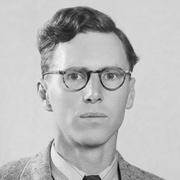
James Harris
James Walter Louis Degal Harris was born in Wales in February 1913, and spent some of his childhood in Jersey, one of the Channel Islands. Harris arrived in New Zealand in 1939, with a Master of Arts from Cambridge University. While making films for the Agriculture Department, he played an important role in the founding of the National Film Unit, serving on committees that advised politician JT Paul on fostering production of local films.
By the time Harris was officially appointed at the NFU in September 1941, he was already working on films publicising the war effort. The longest of these was New Zealand Munitions, released early in 1942. His credit for direction on this marks the first time an NFU film was given a director credit, and it would be more than five years before the next.
Put in charge of one of the Miramar production units, with Russell Reid to assist him and Stan Wemyss on camera, Harris set about making short items for the NFU’s weekly reel. Audiences began seeing New Zealanders on the screen more often, as week after week, alongside film from the NZ Cinema Unit in the Middle East, subjects of interest on the home front also appeared. As the NFU developed more confidence, the weekly reel grew in length; from October 1942 it was titled Weekly Review.
Harris worked on over 80 items for Weekly Review before the war ended. Some he wrote, filmed, directed, and edited, but most often he edited and wrote scripts and voiceover commentaries. A versatile contributor to the filmmaking team, on many occasions he shot film for others to edit and complete.
In late January 1946, Harris flew to Japan in time to film the arrival of Jayforce. Chosen for his camera experience, he filmed many aspects of the NZ contribution to the Commonwealth Occupation Force over the next few months.
In 1947 Harris took a year’s leave from the NFU, and travelled to Europe. In London he filmed the Oldman collection of Pacific artefacts that had just been acquired by the NZ Government. The footage was incorporated into Weekly Review No. 378, released in December 1948, as the collection was being unpacked at Wellington’s Dominion Museum.
Among his later documentary films for the Weekly Review series were edition 403, Fiordland Expedition and number 413, From Potter’s Wheel to Mass Production. He edited and wrote the commentaries for both in 1949. He also edited and wrote the commentary for three of the 13 reels making up the feature 1950 British Empire Games, a team effort from the entire NFU team.
For several years after the demise of Weekly Review, the focus of the NFU was on generally unremarkable departmental information films like Poverty Bay Problems. From late 1952 regular routines returned, thanks to the NFU’s monthly release Pictorial Parade. With the help of Peter Hutt, Harris played a major part in initiating and guiding this series in its early years. During the royal visit of 1953-54, Harris was director of the NFU’s black and white coverage, which was released weekly over seven Royal Tour Special issues of Pictorial Parade. Over 70 items in this series were written, directed or edited by Harris — but only one, Pictorial Parade No. 167 – Eclipse of the Sun (1965) carries an on-screen credit acknowledging his role as director.
His varied talents were called on for films as diverse as a simple trailer promoting a government loan issue, which he wrote and edited, to the two-reel colour film Endeavour in the Islands (1959) which he wrote, edited, directed and partly filmed. He made a similar wide-ranging contribution to Flare on the Sun (1959), showing New Zealand research work in International Geophysical Year, and The Moa was Radioactive (1962), whose title refers to radiocarbon dating. Other significant films include Volcanic Power (1962) whose account of geothermal power generation made use of sequences by Levin-based animator Bob Morrow, and The Young Giant Kaingaroa (1966), which he wrote and edited, about the milling of timber from one of the world’s largest exotic forests.
In addition to his film work, Harris wrote stories and articles for publications as diverse as the New Zealand School Journal, The Public Service Journal, and New Zealand New Writing. His interest in poetry found expression in the verse commentary he wrote for The Lakes at Tutira — an item in Weekly Review No. 395 (1949) — and the rhyming couplets composed for Fred O’Neill anti-smoking film Space Flight (1962). Another film featuring O’Neill’s quirky animation, Legend of Rotorua, was written and directed by Harris. It was one of the last films he worked on before resigning from the NFU at the end of March 1967.
Having retired to Waikanae, James Harris died on 14 March 1992, aged 79.
Writing and original research by Clive Sowry; published on 30 June 2016
Sources include
Photo of James Harris courtesy of Archives New Zealand. Reference number AAQT 6401 A23,729
James Harris, 'Oldman Collection is Full of Treasures of the Old Pacific' – The Evening Post, 1 December 1948, page 12
James Harris, 'Newsreel Angles on Japan' – New Zealand Listener, 12 July 1946, page 6 (volume 15, no 368)
James Harris, 'Making the New Zealand “Weekly Review”' – The Public Service Journal, January 1946, page 10 (volume 33, no 1)
James Harris, 'A Surf Rescue' – New Zealand School Journal, November 1945, page 298 (volume 39, no 10: Part III)
James Harris, 'Wellington after London' – Screen Parade, January 1945, page 13
'Harris, James W' (Death Notice) – The Evening Post, 16 March 1992, page 27
‘Permanent Records of the Royal Tour’ – New Zealand Listener, 29 January 1954, page 6 (volume 30, no 758)
Ian A Gordon (Editor), New Zealand New Writing Number Three (Wellington: Progressive Publishing Society, 1944)